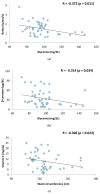Serum Antioxidant Associations with Metabolic Characteristics in Metabolically Healthy and Unhealthy Adolescents with Severe Obesity: An Observational Study
- PMID: 29385682
- PMCID: PMC5852726
- DOI: 10.3390/nu10020150
Serum Antioxidant Associations with Metabolic Characteristics in Metabolically Healthy and Unhealthy Adolescents with Severe Obesity: An Observational Study
Abstract
Considering the inadequacy of some antioxidant nutrients in severely obese adolescents, this study aimed to assess the relationship between antioxidant micronutrients status and metabolic syndrome components in metabolically healthy obesity (MHO) and unhealthy obesity (MUO). We performed an observational study in severely obese adolescents (body mass index > 99th percentile) and they were classified into MHO or MUO, according to the criteria adapted for adolescents. Anthropometric, biochemical, and clinical variables were analyzed to characterize the sample of adolescents. The serum antioxidant nutrients assessed were retinol, β-carotene, Vitamin E, Vitamin C, zinc and selenium. A total of 60 adolescents aged 17.31 ± 1.34 years were enrolled. MHO was identified in 23.3% of adolescents. The MHO group showed lower frequency of non-alcoholic fatty liver disease (14.3% vs. 78.3%, p < 0.001) when compared to MUO. A correlation was found between retinol and β-carotene concentrations with glycemia (r = -0.372; p = 0.011 and r = -0.314; p = 0.034, respectively) and between Vitamin E with waist circumference (r = -0.306; p = 0.038) in the MUO group. The current study shows that some antioxidant nutrients status, specifically retinol, β-carotene, and Vitamin E, are negatively associated with metabolic alterations in MUO. Further studies are necessary to determine the existing differences in the serum antioxidant profile of metabolically healthy and unhealthy obese adolescents.
Keywords: Metabolically Healthy Obesity; adolescents; antioxidants; obesity.
Conflict of interest statement
The authors declare no conflict of interest.
Figures
References
Publication types
MeSH terms
Substances
LinkOut - more resources
Full Text Sources
Other Literature Sources
Medical


